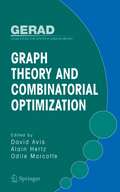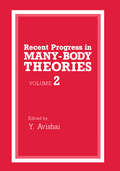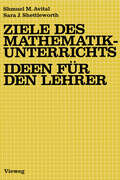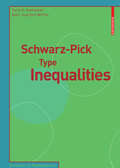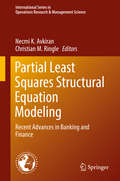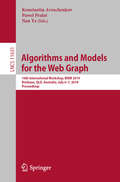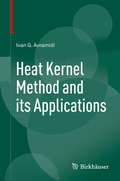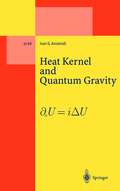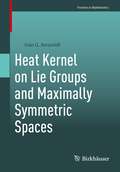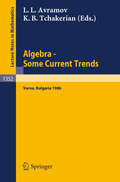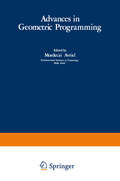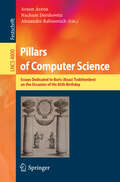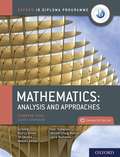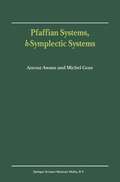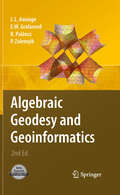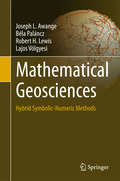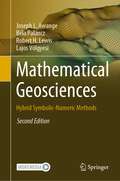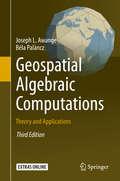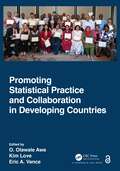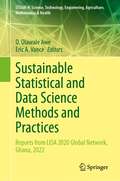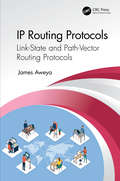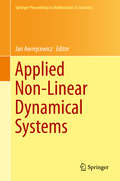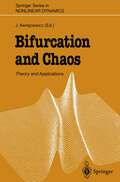- Table View
- List View
Graph Theory and Combinatorial Optimization (Gerad 25th Anniversary Ser. #Vol. 8)
by David Avis Alain Hertz Odile MarcotteGraph theory is very much tied to the geometric properties of optimization and combinatorial optimization. Moreover, graph theory's geometric properties are at the core of many research interests in operations research and applied mathematics. Its techniques have been used in solving many classical problems including maximum flow problems, independent set problems, and the traveling salesman problem. Graph Theory and Combinatorial Optimization explores the field's classical foundations and its developing theories, ideas and applications to new problems. The book examines the geometric properties of graph theory and its widening uses in combinatorial optimization theory and application. The field's leading researchers have contributed chapters in their areas of expertise.
Recent Progress in Many-Body Theories: Volume 2
by Y. AvishaiThe present volume contains the texts of the invited talks delivered at the Sixth International Conference on Recent Progress in Many-Body Theories held in Arad, Israel during the period November 5-10 1989. The host institute was the Physics Department at the Ben Gurion University of the Negev. Beside the invited talks there have been also two poster sessions. The general format and style of the meeting followed closely those which had preceded it and evolved from the earlier conferences in the series: Trieste 1978, Oxtapec 1981, Altenberg 1983, San Francisco 1985 and Oulu 1987. The conferences in this series are intended to cover the broad spectrum of modem physics related to the many body problem. It starts on the smallest length scales in dealing with quark gluon plasmas and ends on the largest length scales in tackling many body problems in astrophysics. In between, it is concerned with nuclear physics, solid state physics, statistical mechanics, field theory, molecular dynamics, hydrodynamics, chaos, etc. Like in the Oulu conference, special emphasis has been put on recent developments in high Tc superconductivity. Beside the half day session devoted to it we have also organized an evening round table discussion on the future of the whole subject. Furthermore, a new, and in the opinion of the editor a very refreshing element which was absent in earlier conferences was the presentation of a few talks by experimentalists.
Ziele des Mathematikunterrichts — Ideen für den Lehrer: Ideen für d. Lehrer
by Shmuel M. Avital Sara J. ShettleworthPartial Least Squares Structural Equation Modeling: Recent Advances in Banking and Finance (International Series in Operations Research & Management Science #267)
by Necmi K. Avkiran Christian M. RingleThis book pulls together robust practices in Partial Least Squares Structural Equation Modeling (PLS-SEM) from other disciplines and shows how they can be used in the area of Banking and Finance. In terms of empirical analysis techniques, Banking and Finance is a conservative discipline. As such, this book will raise awareness of the potential of PLS-SEM for application in various contexts. PLS-SEM is a non-parametric approach designed to maximize explained variance in latent constructs. Latent constructs are directly unobservable phenomena such as customer service quality and managerial competence. Explained variance refers to the extent we can predict, say, customer service quality, by examining other theoretically related latent constructs such as conduct of staff and communication skills. Examples of latent constructs at the microeconomic level include customer service quality, managerial effectiveness, perception of market leadership, etc.; macroeconomic-level latent constructs would be found in contagion of systemic risk from one financial sector to another, herd behavior among fund managers, risk tolerance in financial markets, etc. Behavioral Finance is bound to provide a wealth of opportunities for applying PLS-SEM. The book is designed to expose robust processes in application of PLS-SEM, including use of various software packages and codes, including R. PLS-SEM is already a popular tool in marketing and management information systems used to explain latent constructs. Until now, PLS-SEM has not enjoyed a wide acceptance in Banking and Finance. Based on recent research developments, this book represents the first collection of PLS-SEM applications in Banking and Finance. This book will serve as a reference book for those researchers keen on adopting PLS-SEM to explain latent constructs in Banking and Finance.
Algorithms and Models for the Web Graph: 16th International Workshop, WAW 2019, Brisbane, QLD, Australia, July 6–7, 2019, Proceedings (Lecture Notes in Computer Science #11631)
by Konstantin Avrachenkov Paweł Prałat Nan YeThis book constitutes the proceedings of the 16th International Workshop on Algorithms and Models for the Web Graph, WAW 2019, held in Brisbane, QLD, Australia, in July 2019. The 9 full papers presented in this volume were carefully reviewed and selected from 13 submissions. The papers cover topics of all aspects of algorithmic and mathematical research in the areas pertaining to the World Wide Web, espousing the view of complex data as networks.
Heat Kernel Method and its Applications
by Ivan AvramidiThe heart of the book is the development of a short-time asymptotic expansion for the heat kernel. This is explained in detail and explicit examples of some advanced calculations are given. In addition some advanced methods and extensions, including path integrals, jump diffusion and others are presented. The book consists of four parts: Analysis, Geometry, Perturbations and Applications. The first part shortly reviews of some background material and gives an introduction to PDEs. The second part is devoted to a short introduction to various aspects of differential geometry that will be needed later. The third part and heart of the book presents a systematic development of effective methods for various approximation schemes for parabolic differential equations. The last part is devoted to applications in financial mathematics, in particular, stochastic differential equations. Although this book is intended for advanced undergraduate or beginning graduate students in, it should also provide a useful reference for professional physicists, applied mathematicians as well as quantitative analysts with an interest in PDEs.
Heat Kernel on Lie Groups and Maximally Symmetric Spaces (Frontiers in Mathematics)
by Ivan G. AvramidiThis monograph studies the heat kernel for the spin-tensor Laplacians on Lie groups and maximally symmetric spaces. It introduces many original ideas, methods, and tools developed by the author and provides a list of all known exact results in explicit form – and derives them – for the heat kernel on spheres and hyperbolic spaces. Part I considers the geometry of simple Lie groups and maximally symmetric spaces in detail, and Part II discusses the calculation of the heat kernel for scalar, spinor, and generic Laplacians on spheres and hyperbolic spaces in various dimensions. This text will be a valuable resource for researchers and graduate students working in various areas of mathematics – such as global analysis, spectral geometry, stochastic processes, and financial mathematics – as well in areas of mathematical and theoretical physics – including quantum field theory, quantum gravity, string theory, and statistical physics.
Algebra. Some Current Trends: Proceedings of the 5th National School in Algebra, held in Varna, Bulgaria, Sept. 24 - Oct. 4, 1986 (Lecture Notes in Mathematics #1352)
by Luchezar L. Avramov Kerope B. TchakerianAdvances in Geometric Programming (Mathematical Concepts and Methods in Science and Engineering #21)
by Mordecai AvrielIn 1961, C. Zener, then Director of Science at Westinghouse Corpora tion, and a member of the U. S. National Academy of Sciences who has made important contributions to physics and engineering, published a short article in the Proceedings of the National Academy of Sciences entitled" A Mathe matical Aid in Optimizing Engineering Design. " In this article Zener considered the problem of finding an optimal engineering design that can often be expressed as the problem of minimizing a numerical cost function, termed a "generalized polynomial," consisting of a sum of terms, where each term is a product of a positive constant and the design variables, raised to arbitrary powers. He observed that if the number of terms exceeds the number of variables by one, the optimal values of the design variables can be easily found by solving a set of linear equations. Furthermore, certain invariances of the relative contribution of each term to the total cost can be deduced. The mathematical intricacies in Zener's method soon raised the curiosity of R. J. Duffin, the distinguished mathematician from Carnegie Mellon University who joined forces with Zener in laying the rigorous mathematical foundations of optimizing generalized polynomials. Interes tingly, the investigation of optimality conditions and properties of the optimal solutions in such problems were carried out by Duffin and Zener with the aid of inequalities, rather than the more common approach of the Kuhn-Tucker theory.
Pillars of Computer Science: Essays Dedicated to Boris (Boaz) Trakhtenbrot on the Occasion of His 85th Birthday (Lecture Notes in Computer Science #4800)
by Arnon Avron Nachum Dershowitz Alexander RabinovichMathematics: Analysis and Approaches. Standard Level. Course Companion. (PDF)
by Natasha AwadaWritten by experienced practitioners and developed in cooperation with the IB, this conceptbased print and enhanced online course book pack offers the most comprehensive support for the new DP Mathematics: analysis and approaches SL syllabus, for first assessment in 2021.
Pfaffian Systems, k-Symplectic Systems
by A. Awane M. GozeThe theory of foliations and contact forms have experienced such great de velopment recently that it is natural they have implications in the field of mechanics. They form part of the framework of what Jean Dieudonne calls "Elie Cartan's great theory ofthe Pfaffian systems", and which even nowa days is still far from being exhausted. The major reference work is. without any doubt that of Elie Cartan on Pfaffian systems with five variables. In it one discovers there the bases of an algebraic classification of these systems, their methods of reduction, and the highlighting ofthe first fundamental in variants. This work opens to us, even today, a colossal field of investigation and the mystery of a ternary form containing the differential invariants of the systems with five variables always deligthts anyone who wishes to find out about them. One of the goals of this memorandum is to present this work of Cartan - which was treated even more analytically by Goursat in its lectures on Pfaffian systems - in order to expound the classifications currently known. The theory offoliations and contact forms appear in the study ofcompletely integrable Pfaffian systems of rank one. In each of these situations there is a local model described either by Frobenius' theorem, or by Darboux' theorem. It is this type of theorem which it would be desirable to have for a non-integrable Pfaffian system which may also be of rank greater than one.
Algebraic Geodesy and Geoinformatics
by Joseph L. Awange Erik W. Grafarend Béla Paláncz Piroska ZaletnyikWhile preparing and teaching ‘Introduction to Geodesy I and II’ to undergraduate students at Stuttgart University, we noticed a gap which motivated the writing of the present book: Almost every topic that we taught required some skills in algebra, and in particular, computer algebra! From positioning to transformation problems inherent in geodesy and geoinformatics, knowledge of algebra and application of computer algebra software were required. In preparing this book therefore, we have attempted to put together basic concepts of abstract algebra which underpin the techniques for solving algebraic problems. Algebraic computational algorithms useful for solving problems which require exact solutions to nonlinear systems of equations are presented and tested on various problems. Though the present book focuses mainly on the two ?elds, the concepts and techniques presented herein are nonetheless applicable to other ?elds where algebraic computational problems might be encountered. In Engineering for example, network densi?cation and robotics apply resection and intersection techniques which require algebraic solutions. Solution of nonlinear systems of equations is an indispensable task in almost all geosciences such as geodesy, geoinformatics, geophysics (just to mention but a few) as well as robotics. These equations which require exact solutions underpin the operations of ranging, resection, intersection and other techniques that are normally used. Examples of problems that require exact solutions include; • three-dimensional resection problem for determining positions and orientation of sensors, e. g. , camera, theodolites, robots, scanners etc.
Mathematical Geosciences: Hybrid Symbolic-Numeric Methods
by Joseph L. Awange Béla Paláncz Robert H. Lewis Lajos VölgyesiThis book showcases powerful new hybrid methods that combine numerical and symbolic algorithms. Hybrid algorithm research is currently one of the most promising directions in the context of geosciences mathematics and computer mathematics in general. One important topic addressed here with a broad range of applications is the solution of multivariate polynomial systems by means of resultants and Groebner bases. But that’s barely the beginning, as the authors proceed to discuss genetic algorithms, integer programming, symbolic regression, parallel computing, and many other topics.The book is strictly goal-oriented, focusing on the solution of fundamental problems in the geosciences, such as positioning and point cloud problems. As such, at no point does it discuss purely theoretical mathematics. "The book delivers hybrid symbolic-numeric solutions, which are a large and growing area at the boundary of mathematics and computer science." Dr. Daniel Lichtbau
Mathematical Geosciences: Hybrid Symbolic-Numeric Methods
by Joseph L. Awange Béla Paláncz Robert H. Lewis Lajos VölgyesiThis second edition of Mathematical Geosciences book adds five new topics: Solution equations with uncertainty, which proposes two novel methods for solving nonlinear geodetic equations as stochastic variables when the parameters of these equations have uncertainty characterized by probability distribution. The first method, an algebraic technique, partly employs symbolic computations and is applicable to polynomial systems having different uncertainty distributions of the parameters. The second method, a numerical technique, uses stochastic differential equation in Ito form; Nature Inspired Global Optimization where Meta-heuristic algorithms are based on natural phenomenon such as Particle Swarm Optimization. This approach simulates, e.g., schools of fish or flocks of birds, and is extended through discussion of geodetic applications. Black Hole Algorithm, which is based on the black hole phenomena is added and a new variant of the algorithm code is introduced and illustrated based on examples; The application of the Gröbner Basis to integer programming based on numeric symbolic computation is introduced and illustrated by solving some standard problems; An extension of the applications of integer programming solving phase ambiguity in Global Navigation Satellite Systems (GNSSs) is considered as a global quadratic mixed integer programming task, which can be transformed into a pure integer problem with a given digit of accuracy. Three alternative algorithms are suggested, two of which are based on local and global linearization via McCormic Envelopes; and Machine learning techniques (MLT) that offer effective tools for stochastic process modelling. The Stochastic Modelling section is extended by the stochastic modelling via MLT and their effectiveness is compared with that of the modelling via stochastic differential equations (SDE). Mixing MLT with SDE also known as frequently Neural Differential Equations is also introduced and illustrated by an image classification via a regression problem.
Geospatial Algebraic Computations: Theory and Applications
by Joseph Awange Béla PalánczImproved geospatial instrumentation and technology such as in laser scanning has now resulted in millions of data being collected, e.g., point clouds. It is in realization that such huge amount of data requires efficient and robust mathematical solutions that this third edition of the book extends the second edition by introducing three new chapters: Robust parameter estimation, Multiobjective optimization and Symbolic regression. Furthermore, the linear homotopy chapter is expanded to include nonlinear homotopy. These disciplines are discussed first in the theoretical part of the book before illustrating their geospatial applications in the applications chapters where numerous numerical examples are presented. The renewed electronic supplement contains these new theoretical and practical topics, with the corresponding Mathematica statements and functions supporting their computations introduced and applied. This third edition is renamed in light of these technological advancements.
Promoting Statistical Practice and Collaboration in Developing Countries
by O. Olawale Awe"Rarely, but just often enough to rebuild hope, something happens to confound my pessimism about the recent unprecedented happenings in the world. This book is the most recent instance, and I think that all its readers will join me in rejoicing at the good it seeks to do. It is an example of the kind of international comity and collaboration that we could and should undertake to solve various societal problems. This book is a beautiful example of the power of the possible. [It] provides a blueprint for how the LISA 2020 model can be replicated in other fields. Civil engineers, or accountants, or nurses, or any other profession could follow this outline to share expertise and build capacity and promote progress in other countries. It also contains some tutorials for statistical literacy across several fields. The details would change, of course, but ideas are durable, and the generalizations seem pretty straightforward. This book shows every other profession where and how to stand in order to move the world. I urge every researcher to get a copy!" —David Banks from the Foreword Promoting Statistical Practice and Collaboration in Developing Countries provides new insights into the current issues and opportunities in international statistics education, statistical consulting, and collaboration, particularly in developing countries around the world. The book addresses the topics discussed in individual chapters from the perspectives of the historical context, the present state, and future directions of statistical training and practice, so that readers may fully understand the challenges and opportunities in the field of statistics and data science, especially in developing countries. Features • Reference point on statistical practice in developing countries for researchers, scholars, students, and practitioners • Comprehensive source of state-of-the-art knowledge on creating statistical collaboration laboratories within the field of data science and statistics • Collection of innovative statistical teaching and learning techniques in developing countries Each chapter consists of independent case study contributions on a particular theme that are developed with a common structure and format. The common goal across the chapters is to enhance the exchange of diverse educational and action-oriented information among our intended audiences, which include practitioners, researchers, students, and statistics educators in developing countries.
Promoting Statistical Practice and Collaboration in Developing Countries
by O. Olawale Awe Kim Love Eric A. Vance"Rarely, but just often enough to rebuild hope, something happens to confound my pessimism about the recent unprecedented happenings in the world. This book is the most recent instance, and I think that all its readers will join me in rejoicing at the good it seeks to do. It is an example of the kind of international comity and collaboration that we could and should undertake to solve various societal problems. This book is a beautiful example of the power of the possible. [It] provides a blueprint for how the LISA 2020 model can be replicated in other fields. Civil engineers, or accountants, or nurses, or any other profession could follow this outline to share expertise and build capacity and promote progress in other countries. It also contains some tutorials for statistical literacy across several fields. The details would change, of course, but ideas are durable, and the generalizations seem pretty straightforward. This book shows every other profession where and how to stand in order to move the world. I urge every researcher to get a copy!" —David Banks from the Foreword Promoting Statistical Practice and Collaboration in Developing Countries provides new insights into the current issues and opportunities in international statistics education, statistical consulting, and collaboration, particularly in developing countries around the world. The book addresses the topics discussed in individual chapters from the perspectives of the historical context, the present state, and future directions of statistical training and practice, so that readers may fully understand the challenges and opportunities in the field of statistics and data science, especially in developing countries. Features • Reference point on statistical practice in developing countries for researchers, scholars, students, and practitioners • Comprehensive source of state-of-the-art knowledge on creating statistical collaboration laboratories within the field of data science and statistics • Collection of innovative statistical teaching and learning techniques in developing countries Each chapter consists of independent case study contributions on a particular theme that are developed with a common structure and format. The common goal across the chapters is to enhance the exchange of diverse educational and action-oriented information among our intended audiences, which include practitioners, researchers, students, and statistics educators in developing countries.
Sustainable Statistical and Data Science Methods and Practices: Reports from LISA 2020 Global Network, Ghana, 2022 (STEAM-H: Science, Technology, Engineering, Agriculture, Mathematics & Health)
by O. Olawale Awe Eric A. VanceThis volume gathers papers presented at the LISA 2020 Sustainability Symposium in Kumasi, Ghana, May 2–6, 2022. They focus on sustainable methods and practices of using statistics and data science to address real-world problems. From utilizing social media for statistical collaboration to predicting obesity among rural women, and from analyzing inflation in Nigeria using machine learning to teaching data science in Africa, this book explores the intersection of data, statistics, and sustainability. With practical applications, code snippets, and case studies, this book offers valuable insights for researchers, policymakers, and data enthusiasts alike.The LISA 2020 Global Network aims to enhance statistical and data science capability in developing countries through the creation of a network of collaboration laboratories (also known as “stat labs”). These stat labs are intended to serve as engines for development by training the next generation of collaborative statisticians and data scientists, providing research infrastructure for researchers, data producers, and decision-makers, and enabling evidence-based decision-making that has a positive impact on society. The research conducted at LISA 2020 focuses on practical methods and applications for sustainable growth of statistical capacity in developing nations.
IP Routing Protocols: Link-State and Path-Vector Routing Protocols
by James AweyaThis book discusses link-state routing protocols (OSPF and IS-IS), and the path-vector routing protocol (BGP). It covers their most identifying characteristics, operations, and the databases they maintain. Material is presented from a practicing engineer’s perspective, linking theory and fundamental concepts to common practices and real-world examples. Every aspect of the book is written to reflect current best practices using real-world examples. The book begins with a detailed description of the OSPF area types and hierarchical routing, and the different types of routers used in an OSPF autonomous system. The author goes on to describe in detail the different OSPF packet types, and inbound and outbound processing of OSPF link-state advertisements (LSAs). Next, the book gives an overview of the main features of IS-IS. The author then discusses the two-level routing hierarchy for controlling the distribution of intra-domain (Level 1) and inter-domain (Level 2) routing information within an IS-IS routing domain. He then describes in detail IS-IS network address formats, IS-IS routing metrics, IS-IS packet types, IS-IS network types and adjacency formation, IS-IS LSDB and synchronization, and IS-IS authentication. The book then reviews the main concepts of path-vector routing protocols, and describes BGP packet types, BGP session states and Finite State Machine, BGP path attributes types, and BGP Autonomous System Numbers (ASNs). Focuses solely on link-state routing protocols (OSPF and IS-IS), and the only path-vector routing protocol in use today (BGP). Reviews the basic concepts underlying the design of IS-IS and provides a detailed description of IS-IS area types and hierarchical routing, and the different types of routers used by IS-IS. Discusses the two-level routing hierarchy for controlling the distribution of intra-domain (Level 1) and inter-domain (Level 2) routing information within an IS-IS routing domain. Describes in detail BGP packet types, BGP session states and Finite State Machine, BGP path attributes types, and BGP ASNs, includes a high-level view of the typical BGP router and its components, and inbound and outbound message processing. James Aweya, PhD, is a chief research scientist at the Etisalat British Telecom Innovation Center (EBTIC), Khalifa University, Abu Dhabi, UAE. He has authored four books including this book and is a senior member of the Institute of Electrical and Electronics Engineers (IEEE).
IP Routing Protocols: Link-State and Path-Vector Routing Protocols
by James AweyaThis book discusses link-state routing protocols (OSPF and IS-IS), and the path-vector routing protocol (BGP). It covers their most identifying characteristics, operations, and the databases they maintain. Material is presented from a practicing engineer’s perspective, linking theory and fundamental concepts to common practices and real-world examples. Every aspect of the book is written to reflect current best practices using real-world examples. The book begins with a detailed description of the OSPF area types and hierarchical routing, and the different types of routers used in an OSPF autonomous system. The author goes on to describe in detail the different OSPF packet types, and inbound and outbound processing of OSPF link-state advertisements (LSAs). Next, the book gives an overview of the main features of IS-IS. The author then discusses the two-level routing hierarchy for controlling the distribution of intra-domain (Level 1) and inter-domain (Level 2) routing information within an IS-IS routing domain. He then describes in detail IS-IS network address formats, IS-IS routing metrics, IS-IS packet types, IS-IS network types and adjacency formation, IS-IS LSDB and synchronization, and IS-IS authentication. The book then reviews the main concepts of path-vector routing protocols, and describes BGP packet types, BGP session states and Finite State Machine, BGP path attributes types, and BGP Autonomous System Numbers (ASNs). Focuses solely on link-state routing protocols (OSPF and IS-IS), and the only path-vector routing protocol in use today (BGP). Reviews the basic concepts underlying the design of IS-IS and provides a detailed description of IS-IS area types and hierarchical routing, and the different types of routers used by IS-IS. Discusses the two-level routing hierarchy for controlling the distribution of intra-domain (Level 1) and inter-domain (Level 2) routing information within an IS-IS routing domain. Describes in detail BGP packet types, BGP session states and Finite State Machine, BGP path attributes types, and BGP ASNs, includes a high-level view of the typical BGP router and its components, and inbound and outbound message processing. James Aweya, PhD, is a chief research scientist at the Etisalat British Telecom Innovation Center (EBTIC), Khalifa University, Abu Dhabi, UAE. He has authored four books including this book and is a senior member of the Institute of Electrical and Electronics Engineers (IEEE).
Applied Non-Linear Dynamical Systems (Springer Proceedings in Mathematics & Statistics #93)
by Jan AwrejcewiczThe book is a collection of contributions devoted to analytical, numerical and experimental techniques of dynamical systems, presented at the International Conference on Dynamical Systems: Theory and Applications, held in Łódź, Poland on December 2-5, 2013. The studies give deep insight into both the theory and applications of non-linear dynamical systems, emphasizing directions for future research. Topics covered include: constrained motion of mechanical systems and tracking control; diversities in the inverse dynamics; singularly perturbed ODEs with periodic coefficients; asymptotic solutions to the problem of vortex structure around a cylinder; investigation of the regular and chaotic dynamics; rare phenomena and chaos in power converters; non-holonomic constraints in wheeled robots; exotic bifurcations in non-smooth systems; micro-chaos; energy exchange of coupled oscillators; HIV dynamics; homogenous transformations with applications to off-shore slender structures; novel approaches to a qualitative study of a dissipative system; chaos of postural sway in humans; oscillators with fractional derivatives; controlling chaos via bifurcation diagrams; theories relating to optical choppers with rotating wheels; dynamics in expert systems; shooting methods for non-standard boundary value problems; automatic sleep scoring governed by delay differential equations; isochronous oscillations; the aerodynamics pendulum and its limit cycles; constrained N-body problems; nano-fractal oscillators and dynamically-coupled dry friction.
Bifurcation and Chaos: Theory and Applications (Springer Series in Nonlinear Dynamics)
by Jan AwrejcewiczA collection of especially written articles describing the theory and application of nonlinear dynamics to a wide variety of problems encountered in physics and engineering. Each chapter is self-contained and includes an elementary introduction, an exposition of the state of the art, as well as details of recent theoretical, computational and experimental results. Included among the practical systems analysed are: hysteretic circuits, Josephson circuits, magnetic systems, railway dynamics, rotor dynamics and nonlinear dynamics of speech. This book provides important information and ideas for all mathematicians, physicists and engineers whose work in R & D or academia involves the practical consequences of chaotic dynamics.
